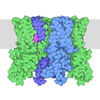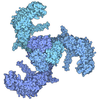+ Open data
Open data
- Basic information
Basic information
| Entry | Database: PDB / ID: 6x2j | ||||||
|---|---|---|---|---|---|---|---|
| Title | Structure of human TRPA1 in complex with agonist GNE551 | ||||||
 Components Components | Transient receptor potential cation channel subfamily A member 1 | ||||||
 Keywords Keywords | MEMBRANE PROTEIN/Agonist / TRPA1 / channel / agonist / MEMBRANE PROTEIN / MEMBRANE PROTEIN-Agonist complex | ||||||
| Function / homology |  Function and homology information Function and homology informationregulation of blood circulation / positive regulation of monoatomic anion transport / cellular response to food / temperature-gated cation channel activity / regulation of neuronal action potential / cellular response to carbon dioxide / osmolarity-sensing monoatomic cation channel activity / stereocilium bundle / detection of chemical stimulus involved in sensory perception of pain / urinary bladder smooth muscle contraction ...regulation of blood circulation / positive regulation of monoatomic anion transport / cellular response to food / temperature-gated cation channel activity / regulation of neuronal action potential / cellular response to carbon dioxide / osmolarity-sensing monoatomic cation channel activity / stereocilium bundle / detection of chemical stimulus involved in sensory perception of pain / urinary bladder smooth muscle contraction / thermoception / cellular response to toxic substance / cellular response to caffeine / response to pain / calcium ion transmembrane import into cytosol / TRP channels / cellular response to cold / intracellularly gated calcium channel activity / detection of mechanical stimulus involved in sensory perception of pain / positive regulation of insulin secretion involved in cellular response to glucose stimulus / voltage-gated calcium channel activity / monoatomic ion transport / sensory perception of pain / response to cold / calcium ion transmembrane transport / calcium channel activity / cellular response to hydrogen peroxide / intracellular calcium ion homeostasis / cellular response to heat / channel activity / protein homotetramerization / cell surface receptor signaling pathway / apical plasma membrane / response to xenobiotic stimulus / axon / identical protein binding / plasma membrane Similarity search - Function | ||||||
| Biological species |  Homo sapiens (human) Homo sapiens (human) | ||||||
| Method | ELECTRON MICROSCOPY / single particle reconstruction / cryo EM / Resolution: 3 Å | ||||||
 Authors Authors | Rohou, A. / Rouge, L. / Chen, H. | ||||||
 Citation Citation |  Journal: Neuron / Year: 2021 Journal: Neuron / Year: 2021Title: A Non-covalent Ligand Reveals Biased Agonism of the TRPA1 Ion Channel. Authors: Chang Liu / Rebecca Reese / Simon Vu / Lionel Rougé / Shannon D Shields / Satoko Kakiuchi-Kiyota / Huifen Chen / Kevin Johnson / Yu Patrick Shi / Tania Chernov-Rogan / Demi Maria Zabala ...Authors: Chang Liu / Rebecca Reese / Simon Vu / Lionel Rougé / Shannon D Shields / Satoko Kakiuchi-Kiyota / Huifen Chen / Kevin Johnson / Yu Patrick Shi / Tania Chernov-Rogan / Demi Maria Zabala Greiner / Pawan Bir Kohli / David Hackos / Bobby Brillantes / Christine Tam / Tianbo Li / Jianyong Wang / Brian Safina / Steve Magnuson / Matthew Volgraf / Jian Payandeh / Jie Zheng / Alexis Rohou / Jun Chen /  Abstract: The TRPA1 ion channel is activated by electrophilic compounds through the covalent modification of intracellular cysteine residues. How non-covalent agonists activate the channel and whether covalent ...The TRPA1 ion channel is activated by electrophilic compounds through the covalent modification of intracellular cysteine residues. How non-covalent agonists activate the channel and whether covalent and non-covalent agonists elicit the same physiological responses are not understood. Here, we report the discovery of a non-covalent agonist, GNE551, and determine a cryo-EM structure of the TRPA1-GNE551 complex, revealing a distinct binding pocket and ligand-interaction mechanism. Unlike the covalent agonist allyl isothiocyanate, which elicits channel desensitization, tachyphylaxis, and transient pain, GNE551 activates TRPA1 into a distinct conducting state without desensitization and induces persistent pain. Furthermore, GNE551-evoked pain is relatively insensitive to antagonist treatment. Thus, we demonstrate the biased agonism of TRPA1, a finding that has important implications for the discovery of effective drugs tailored to different disease etiologies. | ||||||
| History |
|
- Structure visualization
Structure visualization
| Movie |
 Movie viewer Movie viewer |
|---|---|
| Structure viewer | Molecule:  Molmil Molmil Jmol/JSmol Jmol/JSmol |
- Downloads & links
Downloads & links
- Download
Download
| PDBx/mmCIF format |  6x2j.cif.gz 6x2j.cif.gz | 739.6 KB | Display |  PDBx/mmCIF format PDBx/mmCIF format |
|---|---|---|---|---|
| PDB format |  pdb6x2j.ent.gz pdb6x2j.ent.gz | 620.9 KB | Display |  PDB format PDB format |
| PDBx/mmJSON format |  6x2j.json.gz 6x2j.json.gz | Tree view |  PDBx/mmJSON format PDBx/mmJSON format | |
| Others |  Other downloads Other downloads |
-Validation report
| Summary document |  6x2j_validation.pdf.gz 6x2j_validation.pdf.gz | 989.8 KB | Display |  wwPDB validaton report wwPDB validaton report |
|---|---|---|---|---|
| Full document |  6x2j_full_validation.pdf.gz 6x2j_full_validation.pdf.gz | 1004.4 KB | Display | |
| Data in XML |  6x2j_validation.xml.gz 6x2j_validation.xml.gz | 62 KB | Display | |
| Data in CIF |  6x2j_validation.cif.gz 6x2j_validation.cif.gz | 97.3 KB | Display | |
| Arichive directory |  https://data.pdbj.org/pub/pdb/validation_reports/x2/6x2j https://data.pdbj.org/pub/pdb/validation_reports/x2/6x2j ftp://data.pdbj.org/pub/pdb/validation_reports/x2/6x2j ftp://data.pdbj.org/pub/pdb/validation_reports/x2/6x2j | HTTPS FTP |
-Related structure data
| Related structure data |  22009MC M: map data used to model this data C: citing same article ( |
|---|---|
| Similar structure data |
- Links
Links
- Assembly
Assembly
| Deposited unit | 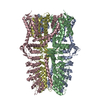
|
|---|---|
| 1 |
|
- Components
Components
| #1: Protein | Mass: 72622.125 Da / Num. of mol.: 4 Source method: isolated from a genetically manipulated source Source: (gene. exp.)  Homo sapiens (human) / Gene: TRPA1, ANKTM1 / Production host: Homo sapiens (human) / Gene: TRPA1, ANKTM1 / Production host:  #2: Chemical | ChemComp-ULJ / Has ligand of interest | Y | |
|---|
-Experimental details
-Experiment
| Experiment | Method: ELECTRON MICROSCOPY |
|---|---|
| EM experiment | Aggregation state: PARTICLE / 3D reconstruction method: single particle reconstruction |
- Sample preparation
Sample preparation
| Component | Name: TRPA1 bound by agonist GNE551 / Type: COMPLEX / Entity ID: #1 / Source: RECOMBINANT | ||||||||||||||||||||
|---|---|---|---|---|---|---|---|---|---|---|---|---|---|---|---|---|---|---|---|---|---|
| Molecular weight | Units: MEGADALTONS / Experimental value: NO | ||||||||||||||||||||
| Source (natural) | Organism:  Homo sapiens (human) Homo sapiens (human) | ||||||||||||||||||||
| Source (recombinant) | Organism:  | ||||||||||||||||||||
| Buffer solution | pH: 8.2 | ||||||||||||||||||||
| Buffer component |
| ||||||||||||||||||||
| Specimen | Conc.: 0.33 mg/ml / Embedding applied: NO / Shadowing applied: NO / Staining applied: NO / Vitrification applied: YES | ||||||||||||||||||||
| Specimen support | Details: Solarus plasma cleaner / Grid material: GOLD / Grid mesh size: 300 divisions/in. / Grid type: Quantifoil R0.6/1 | ||||||||||||||||||||
| Vitrification | Instrument: FEI VITROBOT MARK IV / Cryogen name: ETHANE / Humidity: 100 % / Chamber temperature: 277 K Details: Triple blot. Put blot in vitroblot Apply 3.5ul to grid, wait 30sec, blot manually Apply 3.5ul to grid, wait 30sec, blot manually, apply final 3.5ul, final blot by vitrobot (3.5s) |
- Electron microscopy imaging
Electron microscopy imaging
| Experimental equipment |  Model: Titan Krios / Image courtesy: FEI Company |
|---|---|
| Microscopy | Model: FEI TITAN KRIOS |
| Electron gun | Electron source:  FIELD EMISSION GUN / Accelerating voltage: 300 kV / Illumination mode: FLOOD BEAM FIELD EMISSION GUN / Accelerating voltage: 300 kV / Illumination mode: FLOOD BEAM |
| Electron lens | Mode: BRIGHT FIELD / Nominal magnification: 165000 X / Cs: 2.7 mm / C2 aperture diameter: 70 µm / Alignment procedure: COMA FREE |
| Specimen holder | Cryogen: NITROGEN / Specimen holder model: FEI TITAN KRIOS AUTOGRID HOLDER |
| Image recording | Average exposure time: 1.6 sec. / Electron dose: 41.8 e/Å2 / Detector mode: COUNTING / Film or detector model: GATAN K2 QUANTUM (4k x 4k) / Num. of grids imaged: 1 / Num. of real images: 11063 |
| EM imaging optics | Energyfilter name: GIF Bioquantum / Energyfilter slit width: 20 eV |
| Image scans | Sampling size: 5 µm / Movie frames/image: 40 / Used frames/image: 1-40 |
- Processing
Processing
| EM software |
| ||||||||||||||||||||||||||||||||||||||||||||||||
|---|---|---|---|---|---|---|---|---|---|---|---|---|---|---|---|---|---|---|---|---|---|---|---|---|---|---|---|---|---|---|---|---|---|---|---|---|---|---|---|---|---|---|---|---|---|---|---|---|---|
| CTF correction | Type: PHASE FLIPPING AND AMPLITUDE CORRECTION | ||||||||||||||||||||||||||||||||||||||||||||||||
| Particle selection | Num. of particles selected: 505112 | ||||||||||||||||||||||||||||||||||||||||||||||||
| Symmetry | Point symmetry: C4 (4 fold cyclic) | ||||||||||||||||||||||||||||||||||||||||||||||||
| 3D reconstruction | Resolution: 3 Å / Resolution method: FSC 0.143 CUT-OFF / Num. of particles: 58837 / Algorithm: FOURIER SPACE Details: Data at spatial frequencies higher than 1/4.0 A-1 were not used during any part of the refinement. The final map was density-modified using Phenix. Symmetry type: POINT | ||||||||||||||||||||||||||||||||||||||||||||||||
| Atomic model building | Protocol: AB INITIO MODEL / Space: REAL | ||||||||||||||||||||||||||||||||||||||||||||||||
| Atomic model building | PDB-ID: 6PQQ Accession code: 6PQQ / Source name: PDB / Type: experimental model |
 Movie
Movie Controller
Controller



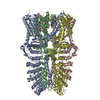
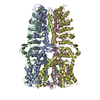
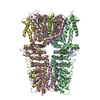

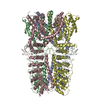


 PDBj
PDBj